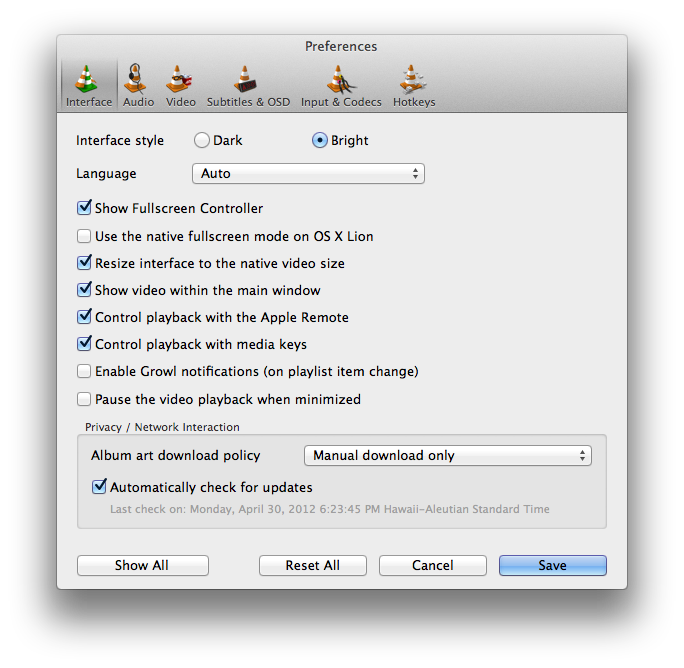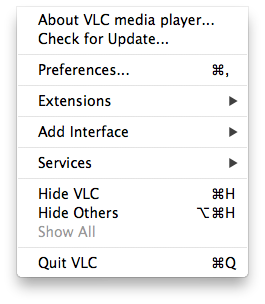Vlc Player Mac Wikipedia
Full list of the top Video Software apps that are similar to VLC Media Player, including Flip Player, Free Mac Bluray Player, Macgo Free Media Player, Aurora Bluray Player, Air Video Server HD.
- VLCメディアプレーヤー(VLC media player, VideoLAN Client)は、クロスプラットフォームで動作するメディアプレーヤーである。 非常に多くのメディアファイル用コーデックが内蔵されており、動画ファイルや音声ファイルなど多くのメディアファイルを再生、表示することができる。.
- Go to the video you want to download. In a web browser, go to.
- VLC for Mac OS X VLC is a free and open source cross-platform multimedia player and framework that plays most multimedia files as well as DVDs, Audio CDs, VCDs, and various streaming protocols.
- VLC is a free and open source cross-platform multimedia player and framework that plays most multimedia files as well as DVDs, Audio CDs, VCDs, and various streaming protocols.
Frequently Asked Questions
view this alone
- 3Latest developments
- 3.2Command line
Graphical Interface
Many people who want to use VLC media player on macOS will be intending to use the standard graphical interface that is provided by VLC. The standard interface consists of the eight menus in the menu bar and the 'VLC - Controller' window that opens up by default. This section outlines what VLC can do for you (at V0.8.6a current active is V3.0.10) and will be completed as I check the use of menu options.
The ten menu bar options are listed below along with the main interesting capabilities under each menu item:
- VLC which allows you to check for an updated application, to access the preferences, and to add an interface.
- File which allows you to open a media file, or an associated file (such as subtitles). It also has a wizard to allow the streaming of video, or the capturing of a streamed video to a file.
- Edit which does nothing VLC-specific.
- View which allows you to hide or show various options like previous/next buttons, shuffle and repeat, audio effects, sidebar, as well as customize what you see in 'playlist table columns'.
- Playback allows you do do all the things you might expect from a video player; some of these features are duplicated graphically in the 'Controller' window.
- Audio allows you to control the audio level, as well as the output device and the audio track to use from the input.
- Video allows you to control the video display on your screen, as well as which device to display on, and which video source to show in that display.
- Subtitles allows you to add subtitle files to your video, as well as change the appearance of subtitle text for your video.
- Window allows you to display seven helper windows that will display information about VLC's activity, and control more detail of that activity.
- Help gives access to the help that came with the installation, the help info on the VideoLAN site, and access to interaction mechanisms with the VLC developers.
In general, many users find that they can get what they want from VLC 'straight out of the box', and may only want more advanced controls after becoming familiar with the regular interface.
Keyboard Shortcuts
You can find most of the keyboard shortcuts by taking a look at the menus. Additional hotkeys are defined in the section 'Hotkeys' of your VLC preferences.
Some handy key combos are:
- Spacebar – pause/unpause the video
- ⌘ + F – toggle fullscreen (Escape will also exit fullscreen)
- ⌘ + Shift + left/right arrow keys – jump the video back/forward about a minute
- ⌘ + Ctrl + left/right arrow keys – jump the video back/forward about ten seconds
- When watching a DVD, and the video window is the front-most window, arrow keys and the enter key will allow you to navigate the DVD menus
- F key – Decrease Audio Delay in milliseconds
- G key – Increase Audio Delay in milliseconds
- H key – Decrease Subtitle Delay
- J key – Increase Subtitle Delay
Latest developments
Streaming Wizard
A streaming wizard has been available since the VLC media player 0.8.4 release. This is available under the 'File' menu.
Command line
You can run VLC on macOS using a terminal application (for example Terminal.app in /Applications/Utilities) with the following command:
On most Bourne-like shells, you can set an alias to just vlc with the following command:

It can be helpful to add this command to your shell setup file.
This option can also be activated from the 'VLC' menu.
Command line examples
~ will expand to /Users/<username>
Following command does this: Transform video-filter (flip vertically), transcode (save) to file.
-I rc is so that it doesn't open the GUI, but stays on the command line version--vout-filter defines the filter to use--transform-type defines the attributes of the transform filter/Movie.mov is the file to convert--sout= is the stream output chain/output.mp4 is the output file name
Another Example
I had a heck of a time getting this to work the way I wanted it. I kept attempting a command-line execution of VLC to only get the following response (not what I wanted):
What I wasn't doing apparently was specifying the location of the source movie.
Eventually I ran this:
HINT:
This would be the same as if you didn't have an alias for vlc that pointed to the actual Applications executable:
Hopefully, I'll add to this post when the transcoding finishes and I see my results (I have no idea if I've got the correct options for vp8/vorbis webm-container transcoding)...
No Dock
In previous versions you can replace the VLC at the end of the path with clivlc to suppress the launch of any Mac-like interface (VLC wouldn't even appear in the Dock then) or if transcoding from the command-line crashed with a Bus error.

Xbox 360 gamertag search email. Garmin g1000 simulator download for mac. This does not work anymore (see Forum thread #58378)
As given by Command-line interface#macOS, specify the option -I followed by the interface you want to add e.g. VLC -Idummy.
Need Help?
Pokemon leaf green extreme randomizer nuzlocke download. See the FAQ on macOS only issues or the Common Problems pages.
Devices and Mac OS X version
VLC media player requires Mac OS X 10.7.5 or later. It runs on any Mac with a 64-bit Intel processor or an Apple Silicon chip. Previous devices are supported by older releases.
Note that the first generation of Intel-based Macs equipped with Core Solo or Core Duo processors is no longer supported. Please use version 2.0.10 linked below.
If you need help in finding the correct package matching your Mac's processor architecture, please see this official support document by Apple.
Web browser plugin for Mac OS X
Support for NPAPI plugins was removed from all modern web browsers, so VLC's plugin is no longer maintained. The last version is 3.0.4 and can be found here. It will not receive any further updates.
Older versions of Mac OS X and VLC media player
We provide older releases for users who wish to deploy our software on legacy releases of Mac OS X. You can find recommendations for the respective operating system version below. Note that support ended for all releases listed below and hence they won't receive any further updates.
Mac OS X 10.6 Snow Leopard
Use VLC 2.2.8. Get it here.
Mac OS X 10.5 Leopard
Vlc Player Mac Os

Use VLC 2.0.10. Get it for PowerPC or 32bit Intel.
Mac OS X 10.4 Tiger
Vlc Player Mac Wikipedia Software
Mac OS X 10.4.7 or later is required
Use VLC 0.9.10. Get it for PowerPC or Intel.
Mac OS X 10.3 Panther
QuickTime 6.5.2 or later is required
Use VLC 0.8.6i. Get it for PowerPC.

Mac OS X 10.2 Jaguar
Use VLC 0.8.4a. Get it for PowerPC.
Mac OS X 10.0 Cheetah and 10.1 Puma
Use VLC 0.7.0. Get it for PowerPC.